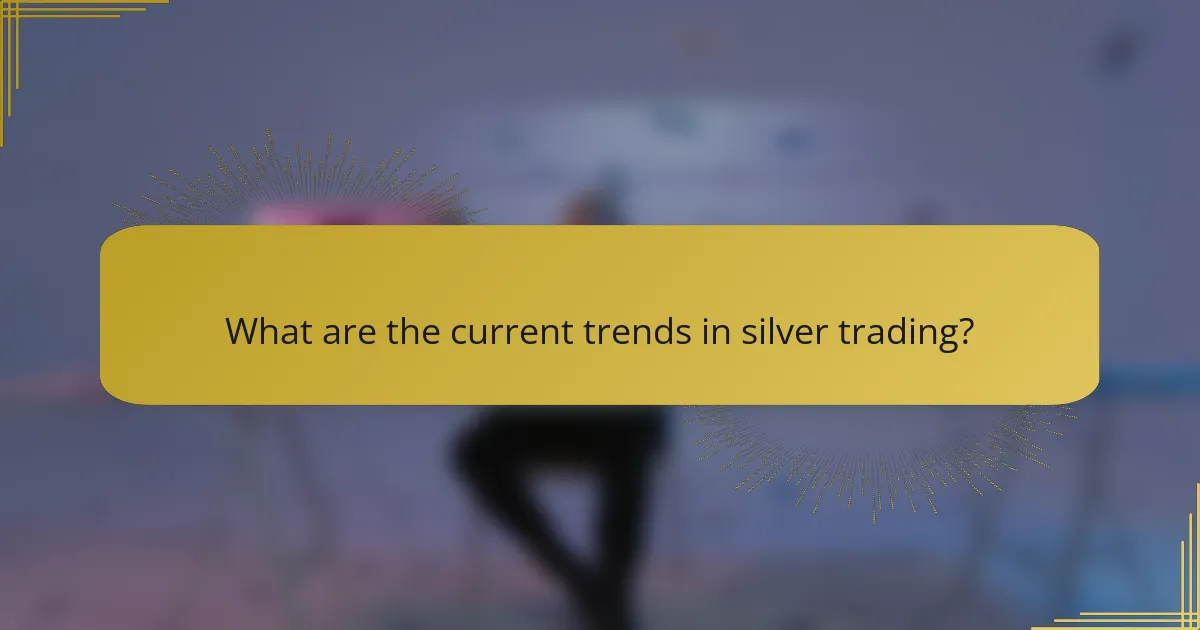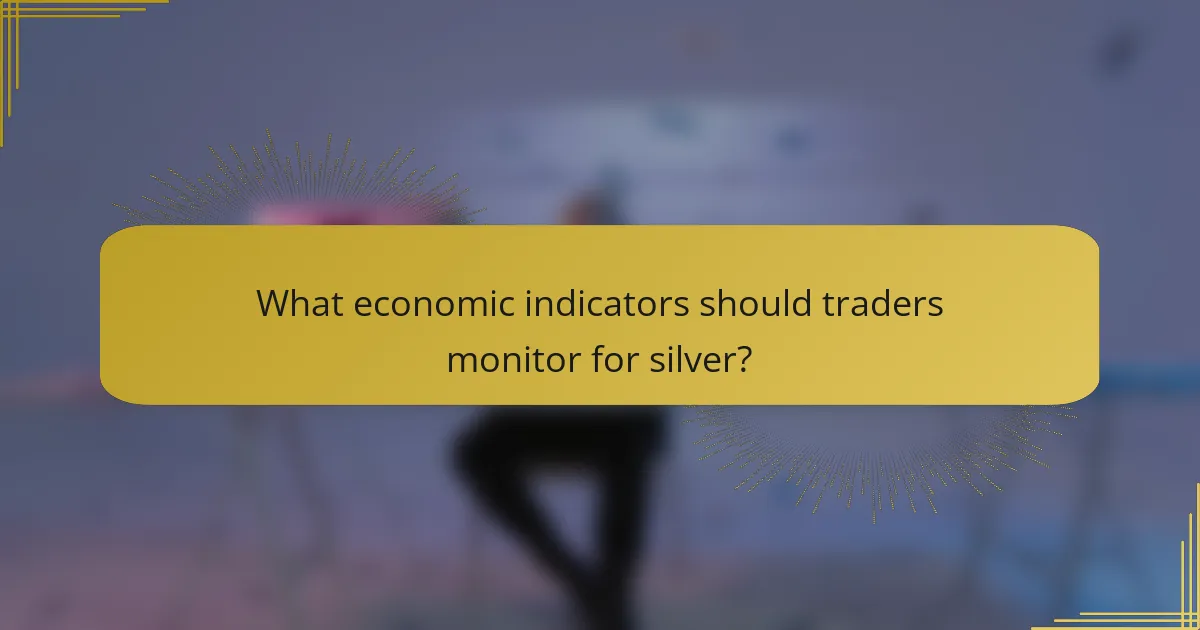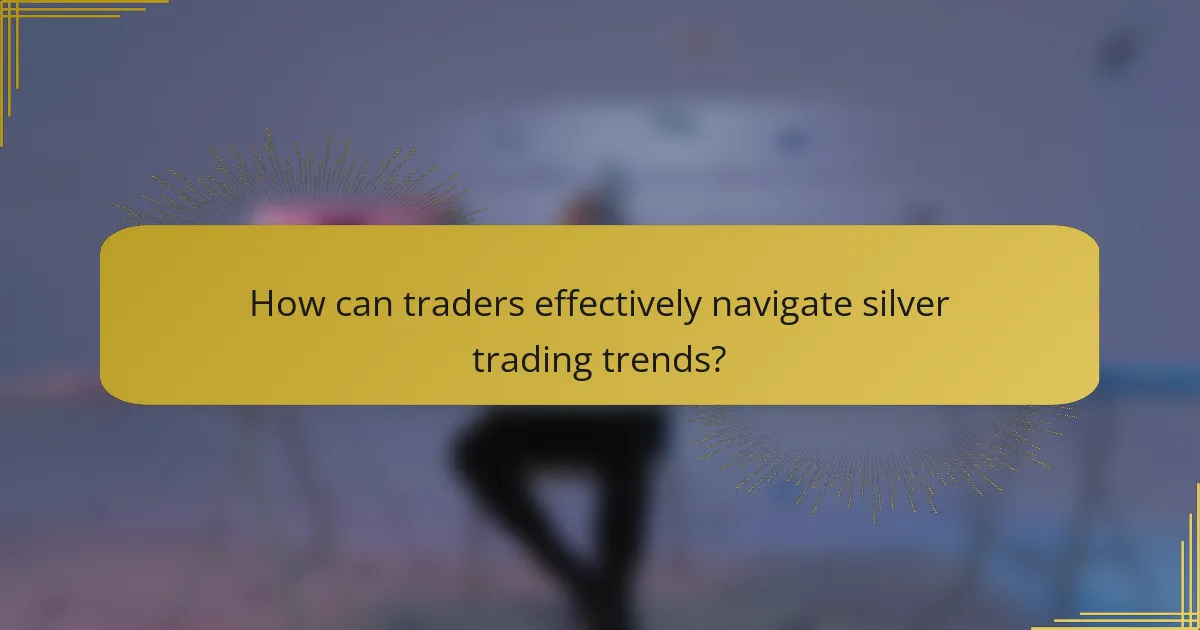Silver trading is currently experiencing increased demand as investors seek safe-haven assets amid economic uncertainty. The price of silver has shown significant fluctuations, reaching highs of approximately $26 per ounce in 2023 due to inflation concerns and geopolitical tensions. Key economic indicators such as interest rates, inflation rates, and the strength of the U.S. dollar play a critical role in influencing silver prices. Additionally, growing industrial demand in sectors like electronics and solar energy further impacts the silver market. Traders are urged to analyze these economic factors and historical trends to navigate the dynamic landscape of silver trading effectively.

What are the current trends in silver trading?
Current trends in silver trading show increased demand due to economic uncertainty. Investors are turning to silver as a safe-haven asset. The price of silver has fluctuated significantly in recent months. In 2023, the price reached highs of around $26 per ounce. This rise is attributed to inflation concerns and geopolitical tensions. Additionally, industrial demand for silver is growing in sectors like electronics and solar energy. The silver market is also influenced by central bank policies and interest rates. Overall, the silver trading landscape is dynamic, reflecting broader economic indicators.
How do market fluctuations impact silver trading?
Market fluctuations significantly impact silver trading by influencing prices and demand. When market volatility increases, investors often seek safe-haven assets like silver. This increased demand can drive up silver prices. Conversely, during stable market conditions, silver may experience lower demand, leading to decreased prices. Historical data shows that silver prices can react sharply to economic reports, geopolitical tensions, or changes in interest rates. For instance, in March 2020, silver prices surged due to market uncertainty from the COVID-19 pandemic. Thus, market fluctuations directly correlate with silver trading dynamics, affecting both investor behavior and pricing trends.
What are the primary factors driving market fluctuations in silver?
The primary factors driving market fluctuations in silver include supply and demand dynamics, economic indicators, and investor sentiment. Supply factors include mining production levels and recycling rates. Demand is influenced by industrial usage, particularly in electronics and solar panels. Economic indicators such as inflation rates and currency strength impact silver’s appeal as a hedge. Investor sentiment is shaped by market trends and geopolitical events. For instance, during economic uncertainty, silver often sees increased investment as a safe haven asset. Historical data shows that significant price movements frequently correlate with changes in these factors, highlighting their role in market fluctuations.
How do geopolitical events influence silver prices?
Geopolitical events significantly influence silver prices by creating uncertainty in the market. When tensions arise, investors often seek safe-haven assets like silver. This increased demand typically drives up prices. For instance, during the 2019 U.S.-China trade war, silver prices surged as investors reacted to potential economic instability. Additionally, conflicts or political unrest can disrupt supply chains, further impacting prices. Historical data shows that silver often rises during major geopolitical crises, confirming its status as a protective investment.
Why is silver considered a safe-haven asset?
Silver is considered a safe-haven asset because it retains value during economic uncertainty. Investors often turn to silver when stock markets decline or geopolitical tensions rise. Historically, silver has acted as a hedge against inflation and currency devaluation. For example, during the 2008 financial crisis, silver prices surged as investors sought stability. Additionally, silver has intrinsic value due to its industrial applications and scarcity. This combination of factors reinforces its status as a reliable store of value in turbulent times.
What historical events have affected silver’s status as a safe-haven?
Silver’s status as a safe-haven asset has been influenced by several historical events. The 2008 financial crisis heightened demand for silver as investors sought stability. Economic uncertainty led to increased investment in precious metals. The Great Depression in the 1930s also saw a surge in silver purchases as people sought tangible assets. Additionally, geopolitical tensions, such as the Cold War, drove investors to silver for security. Changes in monetary policy, like the abandonment of the gold standard, further solidified silver’s role as a hedge against inflation. Each of these events underscored silver’s appeal during times of economic distress.
How does silver compare to other precious metals in times of economic uncertainty?
Silver often acts as a safe-haven asset during economic uncertainty, similar to gold. Investors typically turn to silver when market volatility rises. Unlike gold, silver has industrial applications that can affect its price. During economic downturns, silver may experience increased demand for both investment and industrial use. Historical data shows that silver prices tend to rise during financial crises. For example, in 2008, silver prices surged as investors sought stability. Compared to platinum and palladium, silver is more accessible for individual investors. Overall, silver’s dual role as an investment and industrial metal makes it unique among precious metals in uncertain times.

What economic indicators should traders monitor for silver?
Traders should monitor several key economic indicators for silver. These include interest rates, inflation rates, and the U.S. dollar’s strength. Interest rates directly affect the opportunity cost of holding silver. Lower interest rates often lead to higher silver prices. Inflation rates indicate the purchasing power of money, influencing demand for silver as a hedge. A weaker U.S. dollar typically boosts silver prices, as it becomes cheaper for foreign investors. Additionally, industrial demand and geopolitical tensions can impact silver markets. Historical trends show that these indicators are closely correlated with silver price movements. For instance, during periods of high inflation, silver often sees increased demand as a safe-haven asset.
How do inflation rates affect silver trading trends?
Inflation rates significantly influence silver trading trends. When inflation rises, investors often seek safe-haven assets like silver. This demand can drive up silver prices. Historical data shows that during periods of high inflation, such as the 1970s, silver prices surged. Conversely, low inflation tends to decrease interest in silver as an investment. As a result, silver trading volumes may decline. The correlation between inflation and silver prices is evident in market analysis. For instance, in 2021, rising inflation led to increased silver buying activity. Thus, inflation rates play a crucial role in shaping silver trading trends.
What is the relationship between inflation and silver demand?
Inflation typically leads to increased silver demand. Investors often seek silver as a hedge against rising prices. Historical data shows that during periods of high inflation, silver prices tend to rise. For example, in the 1970s, silver surged as inflation rates escalated. This trend reflects silver’s role as a store of value. Additionally, inflation erodes purchasing power, prompting investors to acquire tangible assets like silver. Therefore, the relationship is characterized by a direct correlation between inflation rates and silver demand.
How can traders use inflation data to make informed decisions?
Traders can use inflation data to make informed decisions by analyzing its impact on purchasing power and market sentiment. Inflation data indicates how prices for goods and services are rising. For instance, rising inflation often leads to increased interest rates. Higher interest rates can strengthen the currency, affecting commodity prices, including silver. Traders may adjust their positions based on expected changes in inflation. Historical data shows that silver prices often rise during periods of high inflation as investors seek a hedge. In 2021, inflation rates surged, leading to increased silver demand as a safe-haven asset. Thus, traders monitor inflation reports to anticipate market movements and adjust their strategies accordingly.
What role do interest rates play in silver trading?
Interest rates significantly influence silver trading. Higher interest rates typically strengthen the U.S. dollar. A stronger dollar makes silver more expensive for foreign investors, reducing demand. Conversely, lower interest rates often weaken the dollar. This scenario can increase silver’s appeal as an alternative investment. Historical trends show that during low-interest-rate environments, silver prices tend to rise. For example, in 2020, the Federal Reserve’s rate cuts contributed to a surge in silver prices, reaching an eight-year high. Thus, interest rates play a crucial role in shaping silver market dynamics.
How do changes in interest rates impact silver investment?
Changes in interest rates significantly impact silver investment. When interest rates rise, the opportunity cost of holding non-yielding assets like silver increases. Investors may prefer interest-bearing assets, leading to decreased demand for silver. Conversely, when interest rates fall, the opportunity cost decreases. This can make silver more attractive as a store of value. Historical data shows that during periods of low interest rates, silver prices often rise due to increased investment interest. For example, in 2020, the Federal Reserve’s rate cuts contributed to a surge in silver prices, reaching an 11-year high. Thus, interest rate fluctuations directly influence investor behavior and silver market dynamics.
What strategies can traders adopt based on interest rate trends?
Traders can adopt several strategies based on interest rate trends. One effective strategy is to analyze the correlation between interest rates and silver prices. Historically, rising interest rates tend to strengthen the U.S. dollar, which can negatively impact silver prices. Traders can short silver when anticipating an interest rate hike. Conversely, when interest rates are expected to fall, silver often becomes more attractive as a hedge against inflation. In this scenario, traders might consider going long on silver.
Another strategy is to monitor central bank announcements. Traders should pay attention to Federal Reserve meetings and economic indicators that signal potential interest rate changes. For instance, if the Fed indicates a dovish stance, traders may increase their silver positions. Additionally, using technical analysis can help traders identify key support and resistance levels influenced by interest rate trends.
Finally, incorporating options can provide flexibility. Traders can use options to hedge against adverse movements in silver prices resulting from interest rate fluctuations. This approach allows for risk management while still participating in potential upside.

How can traders effectively navigate silver trading trends?
Traders can effectively navigate silver trading trends by analyzing market indicators and historical price movements. They should monitor economic reports, such as inflation rates and interest rates, which influence silver prices. Understanding supply and demand dynamics is crucial. For example, industrial demand for silver in electronics can drive prices up. Additionally, traders can use technical analysis tools, like moving averages and trend lines, to identify entry and exit points. Staying updated with geopolitical events that affect market sentiment is also important. For instance, uncertainty in global markets often leads to increased silver investment. Engaging in risk management strategies, such as setting stop-loss orders, can help protect against volatility.
What are the best practices for analyzing silver market trends?
The best practices for analyzing silver market trends include using historical data, monitoring economic indicators, and assessing market sentiment. Historical data provides insights into price movements and patterns over time. Economic indicators such as inflation rates, interest rates, and currency strength influence silver prices. Market sentiment can be gauged through investor behavior and news analysis. Utilizing technical analysis tools like moving averages and trend lines helps identify potential price movements. Additionally, keeping abreast of geopolitical events can impact supply and demand dynamics in the silver market. These methods collectively enhance the accuracy of market trend analysis.
What tools and resources can assist traders in market analysis?
Traders can utilize various tools and resources for market analysis. Technical analysis software provides charting capabilities and indicators for price trends. Fundamental analysis tools offer insights into economic indicators and news events. Online trading platforms often include real-time data and analytical tools. Economic calendars help traders track important financial events and reports. News aggregators compile relevant market news from multiple sources. Community forums and social trading platforms allow traders to share insights and strategies. Educational resources such as webinars and articles enhance traders’ understanding of market dynamics. These tools collectively support informed trading decisions.
How can traders develop a robust trading strategy for silver?
Traders can develop a robust trading strategy for silver by analyzing market trends and economic indicators. Understanding historical price movements helps identify patterns. Traders should utilize technical analysis tools like moving averages and trend lines. Incorporating fundamental analysis is crucial; monitoring supply and demand dynamics influences silver prices. Economic indicators such as inflation rates and interest rates impact silver’s attractiveness as an investment. Diversifying trading strategies, including both long and short positions, mitigates risk. Staying updated on geopolitical events can also affect silver prices significantly. Historical data shows that silver often reacts to market volatility, making it essential for traders to adapt their strategies accordingly.
What common mistakes should silver traders avoid?
Silver traders should avoid overtrading. Overtrading can lead to increased transaction costs and emotional decision-making. Many traders enter and exit positions too frequently, which can diminish profits. Lack of a clear trading strategy is another common mistake. A defined strategy helps in making informed decisions. Traders often fail to set stop-loss orders. This oversight can result in significant losses during market downturns. Ignoring market trends is also detrimental. Staying informed about economic indicators is crucial for successful trading. Lastly, traders may underestimate the importance of risk management. Proper risk management protects capital and ensures long-term success.
How can emotional trading impact silver investments?
Emotional trading can significantly impact silver investments by causing irrational decision-making. Investors may buy silver during market highs due to fear of missing out. This behavior can inflate prices temporarily. Conversely, panic selling during market lows can lead to steep declines in silver prices. Research shows that emotional responses often lead to market volatility. A study by the CFA Institute found that emotions can distort rational investment choices. This distortion can result in losses for investors who react impulsively to market fluctuations. Emotional trading undermines long-term investment strategies, especially in commodities like silver.
What strategies can help prevent common trading pitfalls?
Implementing risk management strategies can help prevent common trading pitfalls. Setting stop-loss orders limits potential losses on trades. Diversifying investments reduces exposure to any single asset’s volatility. Conducting thorough market research enhances decision-making based on accurate data. Maintaining a trading journal allows for reflection on past trades and improvement. Following a disciplined trading plan helps avoid emotional decision-making. Staying updated on economic indicators can provide insights into market trends. Adapting strategies based on market conditions ensures relevance and effectiveness.
The main entity of the article is silver trading, which encompasses current market trends, fluctuations, and economic indicators influencing its value. The article outlines how increased demand for silver as a safe-haven asset is driven by economic uncertainty, inflation concerns, and geopolitical tensions, with prices recently reaching around $26 per ounce. It also examines the impact of market fluctuations on silver prices, highlighting key factors such as supply and demand dynamics, interest rates, and investor sentiment. Additionally, the article discusses strategies for traders to effectively navigate the silver market, including monitoring economic indicators and employing risk management techniques.